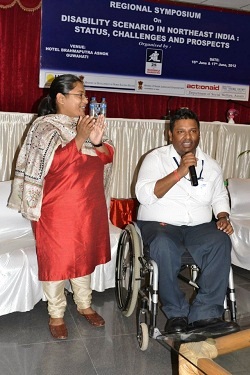Without a doubt, climate change is considered as the most important issue of present day environment. The ever increasing carbon dioxide level in the earth’s atmosphere has led to increased ambient temperature in last few decades. Very recently, reports from NOAA based on observations of Mauna Lowa Observatory, Hawaii has stated that the global atmospheric CO2 level has crossed the mark of 400 ppm. This is indeed a matter of concern as increased level of the green house gas is associated with more and more warming of the atmosphere and resultant change of climate.
The widely known and accepted reality of global warming is that it will potentially result in the change of climate of the earth as a whole. Abnormal rainfall patterns, extreme climatic events like cyclone, storm, cloudburst and drought, abnormal changes in seasonal patterns will be more and more prominent due to this. On the other hand, satellite observations and other researches have revealed that glacier melting is more than a reality under these warming atmospheric situations. Himalayan glaciers have been found to retreat in the last 50 years to a significant extent as per the reports available from remote sensing data.
Another important aspect associated with glacier retreat is that it will cause the global ocean water level to rise higher. Thus a series of negative implications will be initiated with warming of atmosphere which includes inundation of low lying and coastal areas, ground water salinization, loss of soil productivity etc. and these negative impacts will end up in lowering agricultural and allied productivity of a particular region.
The important aspect of climate change originated environmental modifications is that it will affect a region’s socio-economic condition in a vital way. Agriculture, being a climate dependent activity, will be influenced by these changes to a large extent. As we know, still more than 60% of net sown area in India belongs to rainfed agro-ecosystems. As per government statistics, 50% of the grain crops, 80% of horticultural produce, 66% cotton, 77% oil seeds and 84-87% of pulses/minor millets and 66% of livestock are raised in rainfed areas. (www.nraa.gov.in). North east India is also not an exception. This region, although is blessed with a strong agricultural potential with its humid climate, rich water and land resources, spectrum of biodiversity, is yet to achieve the target of agricultural development. It is quite astonishing that even after decades of green revolution in the country, still only 24% of the net sown area of north east India is equipped with irrigation facilities, leaving as high as 76% of the same under rainfed agro-ecosystems. This certainly indicates a possible impact of climate change on the region’s agrarian economy. But, another very important situation is also quite evident if we talk about climate change impacts on north east India and that is possible migration from nearby countries to the region. Geographically, North East India is in close proximity with fiveforeign nation viz. Bangladesh, Bhutan, Nepal and China and Myanmar. Of all these, India has a very amicable bilateral relationship with Bangladesh, Nepal and Bhutan. Incidentally, all of these three countries are considered among the climate change vulnerable countries of South East Asia.
Recently, in the BIMSTEC Conference held in New Delhi during March, 2014, Sheikh Hasina, Prime Minister of Bangladesh has revealed a very serious issue regarding climate change impacts on the country. With increasing global warming, a vast area of Bangladesh will be inundated by ocean water and will be left unproductive. This may cause approximately 30 million people to migrate from their country to the neighbouring nations. IPCC, the global apex body on climate change research in its 4th assessment report has stated that 10 C rise in atmospheric temperature will result in inundation of one fifth of the total land area of Bangladesh forcing the inhabitants of the area to migrate. It was also speculated that climate change will reduce the country’s rice production by 8% along with a decline of 32% in wheat production. Further, warming will also increase the occurrence of flood in low lying areas, salt water intrusion to the ground water as well as cyclone in coastal areas thereby increasing the pressure on people to migrate.
Under a changed climatic scenario, as already speculated, the pressure of migration will be manifold in the state and environmental refugees in large number could be burden from the low lying Bangladesh. The Himalayan States too might suffer from the obvious negative impacts of climate change. Nepal and Bhutan will also experience negative implications of climate change triggering exodus from the countries to India. In this case, the important aspect is the emotional and cultural bonding of people from different parts of north eastern region with the nationals of same ethnicity from these two countries which will most probably be an incentive to attract migration towards India.
Under such circumstances, tackling with these socially, politically and economically important issues is more than a necessity for the region. With present status of regulations relating to global warming, it is quite natural that atmospheric green house gas concentration will increase further until 2025 at least if not 2050, inviting more warming induced affects. Moreover, in reality, at least some amount of migration is inevitable under present circumstances of cross border securities, international and regional politics. So, in order to adapt in a climate change scenario, capacity building is required in the entire region. One possible option to solve this is that of planned and targeted migration, which can be executed at international level. This is because; planned migration can be beneficial both ways i.e. to the country of origin as well as the target country resulting in economic well being of both the nations involved in the process. It is quite important to note that with its vast natural richness, the region has enough potential to adapt with climate change. Use of indigenous traditional knowhow to mitigate the impacts can also prove to be very vital. However, it needs planning and execution well ahead. Otherwise, a volcano of crisis shall erupt in the region with the possible socio- economic impacts of climate migration.







































